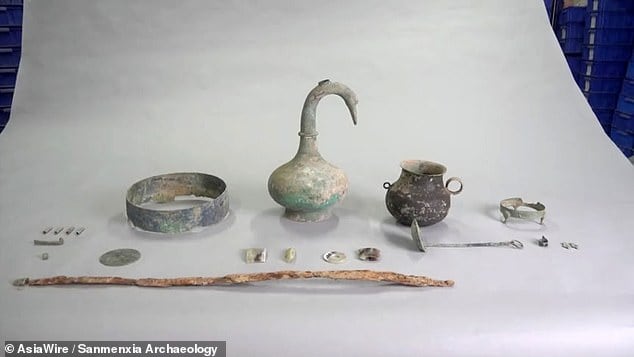A pak kde se berou covidove.... Předposlední fotka mluví za vše........ Být v tom nějaký sajrajt tak je to to poslední co vědec udělal.....
Does the 2000-year-old "swan" jar contain the elixir of immortality?
Categories: Finds and rescue research abroad , Nálezy nejenom s detektorem v Číně

A swan-shaped bronze vessel containing more than three litres of an unknown liquid was discovered last week in the city of Sanmenxia in central China's Henan province. It was lying in a tomb found during a rescue archaeological survey during the construction of a new part of the city. It is the first bronze pot of this type found in Sanmenxia.
The site is located between Xi'an and Luoyang, two historically very important cities. Sanmenxia here served as an important trade, military and transportation artery. As a result, the surrounding area is very rich in historical sites.
The newly discovered tomb has been dated to the late Qin Dynasty (221-207 BC) and early Han Dynasty (202 BC-220 AD). In addition to the bronze vessel, the tomb also contained an iron and jade sword, a helmet, a bronze pot, and various small jade objects. Although these are very successful and finely crafted artefacts, it is not the tomb of an aristocrat. The deceased was probably a titled official of relatively low rank.
Most of the bronze vessels of this period have a more typical pot-like appearance, with animal forms more commonly found as lamps - e.g. Goose lamp discovered in 2018 in a Han dynasty tomb in Luoyang, Henan province. Although initially some were of the opinion that even the newly discovered vessel represented a goose, experts including veterinary experts have confirmed that it is indeed a swan, given its longer beak.
According to archaeologists, ancient craftsmen in the area at the time may have actually observed swans, which they modelled the vessel after. "We can safely guess that swans had already appeared in Sanmenxia during the late Qin and Han dynasties," said Zhu Xiaodong, deputy head of the Sanmenxia Institute of Cultural Relics and Archaeology.
The pale yellow liquid in the jar was originally thought to be rice or sorghum wine, which was known to have been used in Han Dynasty funeral ceremonies. However, it was subsequently discovered that the vessel did not contain alcohol, smelled of earth, and that the liquid may be a much rarer beverage - the so-called "Han". "elixir of life" made from toxic minerals, similar to the discovery of another bronze vessel in a tomb of roughly the same age in Luoyang in October 2018.
The liquid there was a mixture of potassium nitrate and alunite, an arenaceous mineral with disinfectant properties. Indeed, according to ancient Taoist texts, these two ingredients were supposed to serve as the basis of an elixir of immortality. Whether the 'swan' jar also contains the same potion will be determined after analysis by laboratories in Beijing.
Roman Nemec






Sources: china.org.cn, internewscast.com, dailymail.com, archaeology.org, thehistoryblog.com
The article is included in categories:






